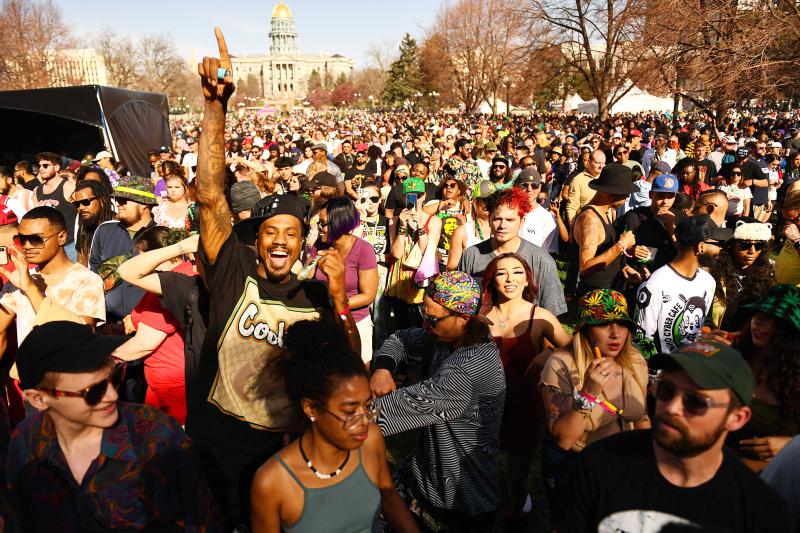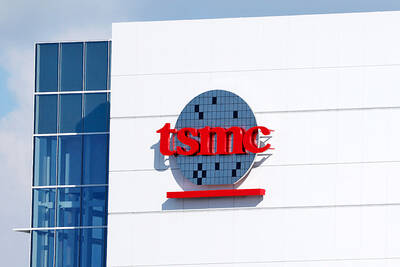Tens of thousands of cannabis enthusiasts gathered in Denver this week to celebrate the ever-widening US legalization of recreational weed with plumes of pungent smoke, music and a few grumblings about commercialization.
April 20 has become the national holiday for pot in the US, as the date corresponds with the “420” slang name for marijuana.
In particular, Colorado’s capital has become a magnet for enthusiasts, as the western US state became the country’s first to vote to legalize recreational cannabis a decade ago.

Photo: AFP
They gathered for festivities on Wednesday afternoon in a park overlooked by the windows of the local Capitol building, where protests to push for decriminalization of marijuana started in the 1990s.
Among the first to arrive at the Mile High 420 Festival — billed as the world’s largest free gathering of its kind — was Michael Farwell, proudly carrying a giant oversized joint measuring about 40cm long, thick as a chair leg.
“It’s the biggest joint I’ve ever smoked — or I’m about to smoke!” the 25-year-old said.

Photo: AFP
“It’s like a six ounce joint, six-and-a-half-ounce joint... I don’t know,” he added, estimating the blunt had cost about US$800 and took more than an hour to roll with the help of two friends.
Farwell made the pilgrimage from the state of Delaware, where cannabis is allowed only for medical use.
“It’s my favorite day of the year. It’s better than Christmas,” he said.
Since Colorado green-lighted recreational cannabis, eighteen of the 50 US states, plus the capital Washington, have followed suit.
However, it remains illegal at a federal level, and even in Colorado, the law technically still prohibits the smoking of marijuana in public places.
Still, festival attendees know that in reality they have little to fear from authorities, and made no effort to hide their favorite pastime.
Things have changed a lot from the more clandestine origins of the festival, said Miguel Lopez, a pro-legalization advocate and cofounder of the “420 Festival.”
In 1995, advocates gathered for “smoke-ins” in protest at the capitol, but had to watch out for police intervention or risk arrest.
Much has changed since then, and legalization went into effect in Colorado in 2014.
However, Lopez said that the festival and the wider legalized marijuana industry have taken a highly commercial turn.
“The message was strong about, you know, we want to legalize, but not at the discretion of legislators who want to just make money,” he said.
The veteran advocate said that legal cannabis sales last year in Colorado — a state of fewer than 6 million people — reached US$2.2 billion.
With that translating to US$423 million in tax revenue in the state’s coffers, in addition to indirect benefits such as tourism, it is little surprise that local officials now support the “420” movement.
“The grassroots didn’t want it this way. The industry wants it. It’s really overregulated, it’s overtaxed,” Lopez said. “It really hasn’t really freed up people, but it’s just made another opportunity for people to come and profit, like oil and gas.”
Lopez, a previous organizer of the festival, was recently ousted by a chain of specialty cannabis stores that have partially rebranded the event.
Still, for Tammy Herndon, this day in the park with a joint in her mouth has a taste of freedom.
She lives in the conservative state of Georgia, where cannabis — even for medical purposes — remains illegal.
Hendon, 54, suffers from trigeminal neuralgia, a painful condition that some studies have shown can be relieved by cannabis.
A former navy veteran, she traveled almost 3,220km to attend the festival.
“It was on my bucket list of things to do,” she said. “Georgia is Bible Belt, so there’s no chance you’ll ever be able to have the freedom to smoke there.”
“I’m a disabled veteran. I’m retired from the navy. If I like to smoke a joint and relax, I should be able to celebrate that,” she added.

Real estate agent and property developer JSL Construction & Development Co (愛山林) led the average compensation rankings among companies listed on the Taiwan Stock Exchange (TWSE) last year, while contract chipmaker Taiwan Semiconductor Manufacturing Co (TSMC, 台積電) finished 14th. JSL Construction paid its employees total average compensation of NT$4.78 million (US$159,701), down 13.5 percent from a year earlier, but still ahead of the most profitable listed tech giants, including TSMC, TWSE data showed. Last year, the average compensation (which includes salary, overtime, bonuses and allowances) paid by TSMC rose 21.6 percent to reach about NT$3.33 million, lifting its ranking by 10 notches

Popular vape brands such as Geek Bar might get more expensive in the US — if you can find them at all. Shipments of vapes from China to the US ground to a near halt last month from a year ago, official data showed, hit by US President Donald Trump’s tariffs and a crackdown on unauthorized e-cigarettes in the world’s biggest market for smoking alternatives. That includes Geek Bar, a brand of flavored vapes that is not authorized to sell in the US, but which had been widely available due to porous import controls. One retailer, who asked not to be named, because

SEASONAL WEAKNESS: The combined revenue of the top 10 foundries fell 5.4%, but rush orders and China’s subsidies partially offset slowing demand Taiwan Semiconductor Manufacturing Co (TSMC, 台積電) further solidified its dominance in the global wafer foundry business in the first quarter of this year, remaining far ahead of its closest rival, Samsung Electronics Co, TrendForce Corp (集邦科技) said yesterday. TSMC posted US$25.52 billion in sales in the January-to-March period, down 5 percent from the previous quarter, but its market share rose from 67.1 percent the previous quarter to 67.6 percent, TrendForce said in a report. While smartphone-related wafer shipments declined in the first quarter due to seasonal factors, solid demand for artificial intelligence (AI) and high-performance computing (HPC) devices and urgent TV-related orders

MINERAL DIPLOMACY: The Chinese commerce ministry said it approved applications for the export of rare earths in a move that could help ease US-China trade tensions Chinese Vice Premier He Lifeng (何立峰) is today to meet a US delegation for talks in the UK, Beijing announced on Saturday amid a fragile truce in the trade dispute between the two powers. He is to visit the UK from yesterday to Friday at the invitation of the British government, the Chinese Ministry of Foreign Affairs said in a statement. He and US representatives are to cochair the first meeting of the US-China economic and trade consultation mechanism, it said. US President Donald Trump on Friday announced that a new round of trade talks with China would start in London beginning today,